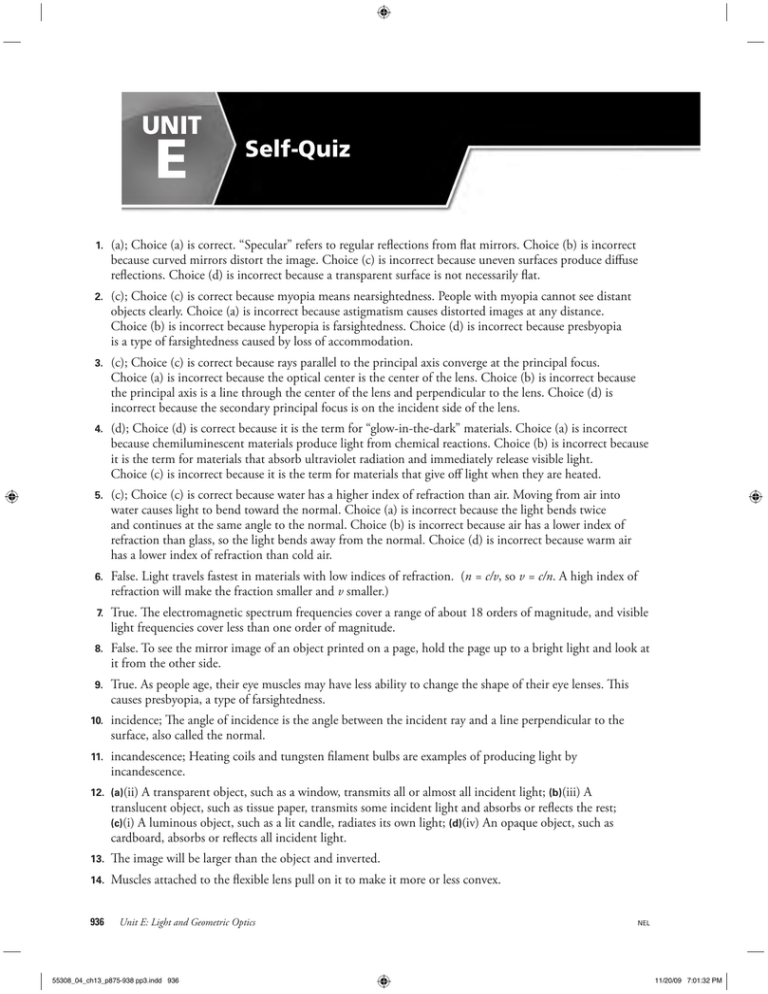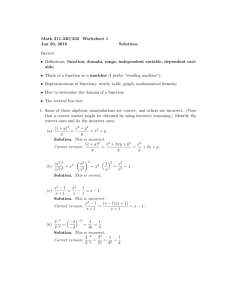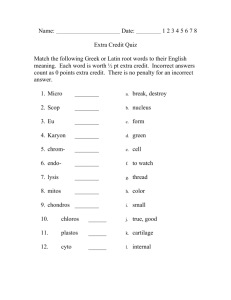E UNIT Self-Quiz
advertisement

UNIT E Self-Quiz 1. (a); Choice (a) is correct. “Specular” refers to regular reflections from flat mirrors. Choice (b) is incorrect because curved mirrors distort the image. Choice (c) is incorrect because uneven surfaces produce diffuse reflections. Choice (d) is incorrect because a transparent surface is not necessarily flat. 2. (c); Choice (c) is correct because myopia means nearsightedness. People with myopia cannot see distant objects clearly. Choice (a) is incorrect because astigmatism causes distorted images at any distance. Choice (b) is incorrect because hyperopia is farsightedness. Choice (d) is incorrect because presbyopia is a type of farsightedness caused by loss of accommodation. 3. (c); Choice (c) is correct because rays parallel to the principal axis converge at the principal focus. Choice (a) is incorrect because the optical center is the center of the lens. Choice (b) is incorrect because the principal axis is a line through the center of the lens and perpendicular to the lens. Choice (d) is incorrect because the secondary principal focus is on the incident side of the lens. 4. (d); Choice (d) is correct because it is the term for “glow-in-the-dark” materials. Choice (a) is incorrect because chemiluminescent materials produce light from chemical reactions. Choice (b) is incorrect because it is the term for materials that absorb ultraviolet radiation and immediately release visible light. Choice (c) is incorrect because it is the term for materials that give off light when they are heated. 5. (c); Choice (c) is correct because water has a higher index of refraction than air. Moving from air into water causes light to bend toward the normal. Choice (a) is incorrect because the light bends twice and continues at the same angle to the normal. Choice (b) is incorrect because air has a lower index of refraction than glass, so the light bends away from the normal. Choice (d) is incorrect because warm air has a lower index of refraction than cold air. 6. False. Light travels fastest in materials with low indices of refraction. (n = c/v, so v = c/n. A high index of refraction will make the fraction smaller and v smaller.) 7. True. The electromagnetic spectrum frequencies cover a range of about 18 orders of magnitude, and visible light frequencies cover less than one order of magnitude. 8. False. To see the mirror image of an object printed on a page, hold the page up to a bright light and look at it from the other side. 9. True. As people age, their eye muscles may have less ability to change the shape of their eye lenses. This causes presbyopia, a type of farsightedness. 10. incidence; The angle of incidence is the angle between the incident ray and a line perpendicular to the surface, also called the normal. 11. incandescence; Heating coils and tungsten filament bulbs are examples of producing light by incandescence. 12. (a)(ii) A transparent object, such as a window, transmits all or almost all incident light; (b)(iii) A translucent object, such as tissue paper, transmits some incident light and absorbs or reflects the rest; (c)(i) A luminous object, such as a lit candle, radiates its own light; (d)(iv) An opaque object, such as cardboard, absorbs or reflects all incident light. 13. The image will be larger than the object and inverted. 14. Muscles attached to the flexible lens pull on it to make it more or less convex. 936 Unit E: Light and Geometric Optics 55308_04_ch13_p875-938 pp3.indd 936 NEL 11/20/09 7:01:32 PM 15. 16. For light passing into a material from air: n 5 (sin i)/(sin R), sin i 5 n(sin R) 5 (1.33) 3 (0.707) 5 0.940, sin21(0.940) 5 70o. 17. (a) (b) The speed of light in a vacuum, c, and the index of refraction of hexane, vhexane. n 5 c/vhexane; vhexane 5 c/n 18. (a) F (b) 19. (a) (b) F The image is smaller, inverted, between F and 2F, and real. Incandescent light bulbs produce light because of high temperatures. Fluorescent light bulbs use ultraviolet light to produce visible light. Sample answer: Although the initial cost of compact fluorescent lights is greater, they save money in the long run because they last longer and use less electricity. Devices that last longer save space in landfills. Also, any device that reduces energy consumption is good for the environment because most electrical energy is still generated with fossil fuels which cause climate change and acid rain. 20. (a) The difference in index of refraction of air and water will diffract light and cause the shark to appear to be closer to the surface than it is. It will be hard to aim correctly and hit the sharks. (b) Sample answer: The best method would be to shoot straight down, when possible, or otherwise aim deeper. This would keep the scientists safely on the boat and help them compensate for the diffraction. 21. (a) To check the magnification of the magnifying glass, measure the height of the image and divide by the height of the object. (b) 22. (a) (b) Use the equation M = hi/ho. The image will be real. f 5 20 cm, do 5 50 cm. di 5 ? Use the equation 1/do 1 1/di 5 1/f 1/di 5 1/f 2 1/do 5 1/20 cm 2 1/50 cm 5 0.03; di 5 1/0.03 5 33 cm. The image will be real and located about 33 cm from the lens, opposite the object. 23. (a) (b) 24. (a) (b) Sample answer: Three uses of electromagnetic radiation are radio waves for listening to the radio, microwaves for cooking food in a microwave oven, and X-rays from a machine for dental exam. radio waves, microwaves, X-rays Wax fills in small scratches and holes in a surface to make it more even and level. This makes reflections from the surface more specular and less diffuse. Sanding a smooth surface with coarse sandpaper makes reflections from the surface more diffuse. NEL 55308_04_ch13_p875-938 pp3.indd 937 Self-Quiz 937 11/20/09 7:01:32 PM





